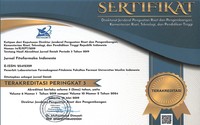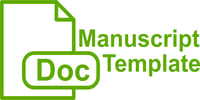Pengembangan Sediaan Serbuk Antidiabetes dari Kombinasi Ekstrak Kulit Buah Manggis (Garcinia Mangostana L.) dan Ekstrak Daun Salam (Syzygium polyanthum (Wight) Walp.)
Abstract
Diabetes mellitus is a metabolic disease characterized by hyperglicemic. Mangosteen (Garcinia mangostana L.) and Salam (Syzygium polyanthum (Wight) Walp.) are plants which recognized as blood glucose controller. The study aims to determine the effectiveness of the combination of the two extract in decreasing blood sugar levels of diabetic rats. The rats divided into 6 groups: group I (normal control) without treatment, group II (negative control), group III (positive control), group IV (extract of mangosteen with dose of 400 mg), group V (extract of salam leaf with dose of 400 mg) and group VI (combination of mangosteen 200 mg and salam leaf 200 mg). Data were analyzed by One-Way Anova, followed by PostHoc Bonferroni analysis. Then the combination of the extract was formulated in powder dosage form blended with PVP, Sucralose and Lactose. The evaluation included physical test are organoleptic, water content and flowability time. The results showed that the combination of the extracts of mangosteen and salam leaf comprising half doses of eact extract could lower blood glucose levels significantly (P<0.05) with better efficacy than each single extract and the combination of extracts able to produce powder dosage form with the requirement (organoleptic, water content and flowability time).
Keywords
Full Text:
PDF (Bahasa Indonesia)References
America Diabetes Association. (2014). Diagnosis and Classification of Diabetes Mellitus, Diabetes Care volume 37, Supplement 1. USA America. (pp 581).
Dewi IL, Sutrisna EM, Azizah T. (2013). Uji Aktivitas Antidiabetes Ekstrak Etanol Daun Salam terhadap Tikus Galur Wistar yang Diinduksi Aloksan. Surakarta: FF Universitas Muhammadiyah Surakarta. (pp 12).
International Diabetes Federation. (2017). IDF Diabetes Atlas Eighth Edition 2017, 8th Edition. (pp 43-46).
Lavle NS, Panchal A. (2016). Role of Flavonoids and Saponins in The Treatment of Diabetes Mellitus. Journal of Pharmaceutical Science and Bioscientific Research. (pp 535-541).
Manurung S, Barung E, Bodhi W. (2012). Efek Antihiperglikemia dari Ekstrak Kulit Buah Manggis (Garcinia mangostana L.) Terhadap Tikus Putih Jantan Galur Wistar (Rattus norvegicus L.) yang Diinduksi Sukrosa. Manado: FMIPA UNSTRAT. (pp 1-10).
Nandhagopal K. Antidiabetic Activity of Karchure Chooranam on Alloxan Induced Diabetic Rats. ISSN: International Journal of Pharma and Bio Sciences. 2013; h 434-439.
Pasaribu F, Sitorus P. (2012). Uji Ekstrak Etanol Kulit Buah Manggis (Garcinia mangostana L.) terhadap Penurunan Kadar Glukosa Darah. USU: Journal of Pharmaceutics and Pharmacology. (pp 1-6).
Peraturan Kepala BPOM Nomor 12 Tahun 2014. (2014). Persyaratan Mutu Obat Tradisional. Jakarta. (pp 11-24).
Pusat Data dan Informasi Kementerian Kesehatan RI. Riset Kesehatan Dasar. Jakarta: Kementerian Kesehatan RI. 2013; h1-6.
Rohyani IS. (2015). Kandungan Fitokimia Beberapa Jenis Tumbuhan Lokal yang sering dimanfaatkan sebagai Bahan Baku Obat di Pulau Lombok. (pp 388-391).
World Health Organization. (2013). WHO Traditional Medicine Strategy. (pp 15-16).
DOI: https://doi.org/10.33096/jffi.v7i1.593
Copyright (c) 2020 Rizki Yulianti R.

This work is licensed under a Creative Commons Attribution-ShareAlike 4.0 International License.
Indexed by:
ISSN: 2356-0398 | e-ISSN: 2541-2329
Editor's Address:
Third Floor Pharmacognosy-phytochemistry laboratory building, Urip Sumoharjo road km. 5 Campus II UMI, Makassar, South Sulawesi, Indonesia
Phone: +6281524045514
Fax: +62411425619
E-mail: editorjfi@umi.ac.id

















.jpg)

